The readers of the world can be pretty brutal. If you do something they really don’t like, they can put the book down, never pick it up again, and then talk about it despairingly online because you did one of their writing pet peeves. While I’d never do the latter unless it was something serious, I have put a book down and never returned to it because the author—for lack of a better word—pissed me off.
It can be brutal, but it’s also just a part of the publishing world. If you want to write and publish books full-time, it comes with the caveat of some readers not only disliking your books, but hating them verbally. One way you can avoid this to come degree is understanding overarching writing pet peeves.
These things will get under a reader’s skin and affect how they experience your book.
I do want to say that pet peeves completely depend on the reader, and you can’t please everyone. This advice is by no means meant to make you change what you write about, but more so to simply understand the mind’s of a reader and avoid major pitfalls before they happen.
In order to do that, I took to the people! Specifically the people of massive online reading group that frequently discusses books, asking about their pet peeves. The post amassed more than 550 comments and I’ve distilled it for you.
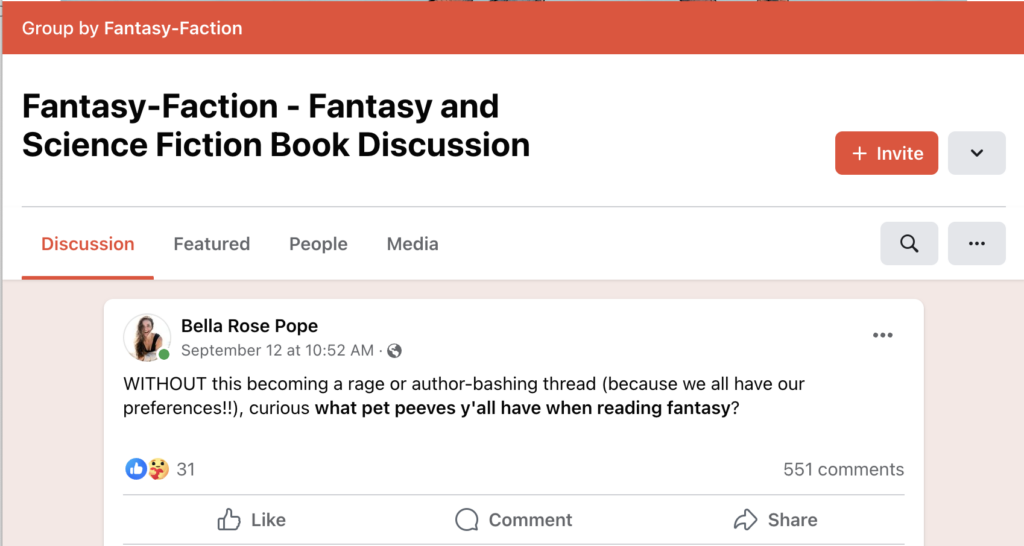
(NOTE: While this post was specific to fantasy, I found that the pet peeves applies across all book genres, and you’ll understand when you read them)
Here are the types of pet peeves we’ll focus on:
Book Pet Peeves
Book pet peeves have much to do with the overall construction or plot of a story. They’re all-encompassing instead of specific to certain elements of fiction.
While some readers might find these to be book pet peeves, keep in mind that others might like them. At the end of the day, if you want to tell this story and find it entertaining, go for it!
1. When religious leaders are the villain
This was one of the most-liked of the responses. It even brought on quite the discussion of why this happens often and what it means, with one reader claiming, “Art imitates life,” that was met with a lot of disagreement.
Regardless of why this is done, it’s not loved by many people, and it’s actually clichéd in many ways. At this point, it’s predictable, which is more of the book pet peeve than anything else. Get more creative than this! Even if the religion is completely made up, you can think of something better.

2. Full cast of morally gray characters
Ultimately, the argument as to why this was one of the writing pet peeves is simply because not all people are morally gray. It’s totally okay to develop your characters to have moral ambiguity, but also make sure some characters are firmly on one side or the other.
Plus, morally gray characters are trendy right now, but won’t always be. The diversity of your cast will make for a more evergreen books.
3. Always including sexism or racism
This may not be possible for truly historical books. Because this original post was in a fantasy Facebook group, we can assume the readers are taking that angle on this specific pet peeve. And they’re right.
If you can come up with many different cultures and magic systems and the worldbuilding necessary for fantasy in the first place, you can imagine a world in which these things don’t exist. Because your books will shape the people who read them, whether you realize it or not. By including these things when it’s not necessary, you’re only contributing the their continuation.
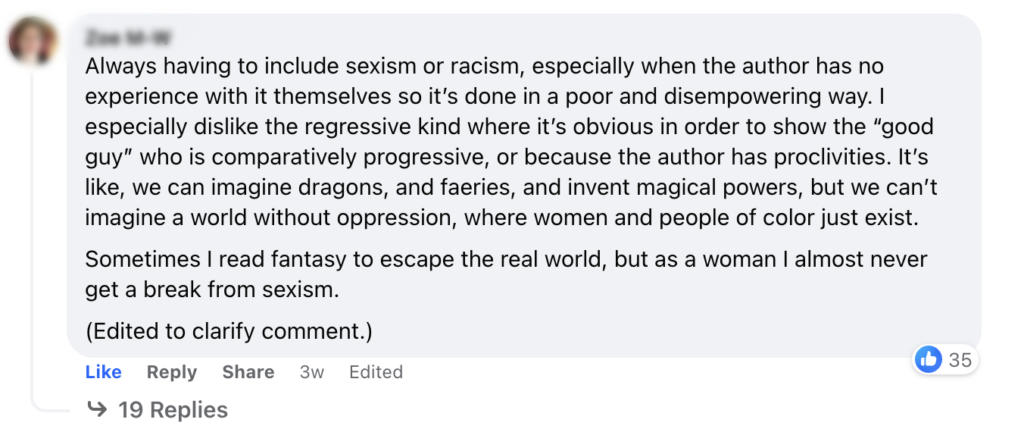
4. When the original book cover is changed to the movie cover
This may be a less-serious one and only reserved for those who “make it” big enough with their book to have a movie or TV show made after them, but there’s no denying that this sucks. Especially for readers who love to collect books.
Just look at these differences—I don’t blame them!

5. Illogical miscommunications
If your entire book or plot is based on the recurring element of miscommunications that don’t really make sense, you’ll annoy readers.
When the plot can be solved by one character simply telling another a piece of information, then it’s a weak plot and needs some work. That’s not necessarily conflict. That’s a convenient way for the author to avoid advancing the plot in believable ways.
Sure, readers will lend some amount of suspension of disbelief, but not that much and not for the entire book with the same issue.
6. Love triangles
Take this one for what you will! Lots of readers are obsessed with love triangles, which is why there are so many. Others really, really hate it. Just be aware that if you include a love triangle, you run the risk of alienating a large part of your audience.
If you lean into it, though, you may end up with a highly targeted audience who loves it.
Here’s more on this discussion:
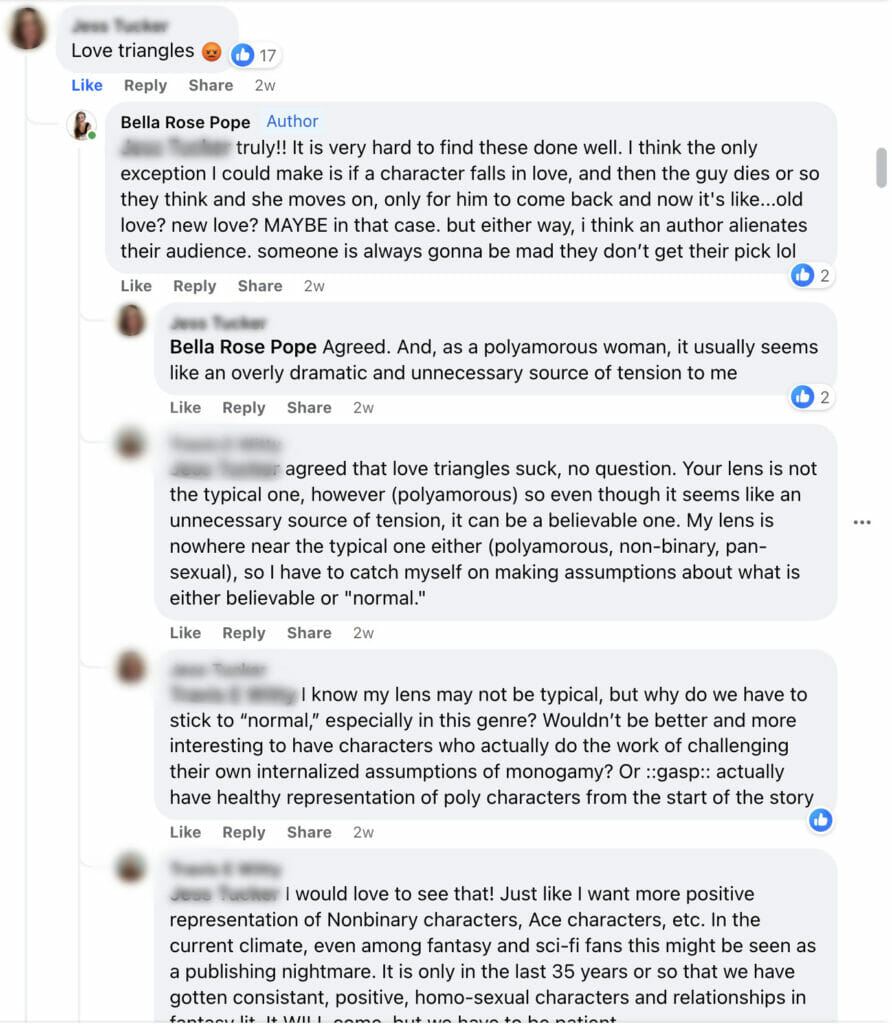
7. Gaps in technology level
Consistency is so important in fiction. It’s what allows the suspension of disbelief to be warranted. When you completely take someone out of the story by making one technological thing available while another that would likely be the case not, it can be detrimental.
When you’re writing fantasy, specifically, because most fantasy is set in its own world but does have elements based in ours, like oil lamps, swords, and the like.
8. The “chosen one” who’s a teenager
I think many readers are just tired of this one—especially in the fantasy genre. They want something a bit more unexpected, like a male in his mid 40s or a mom with three kids. It can get frustrating to a reader when all these big, epic stories are centered around a teenager when the reader is an adult.
So this, among the other writing pet peeves, will be formed. Plus, there’s market opportunity for a non-teenager chosen one. Get on it!
9. Insta-love that lacks depth
There’s a rise in the romance genre. If you’re writing a romance novel, it’s for a good reason. It’s an incredibly popular genre that many authors are flocking to, without quite realizing that the romance stories that truly stick in our hearts are the ones with depth, meaning, and a realistic romance.
Not stories where two people fall in love at the drop of a hat, or are “fated” to be together. While the latter is a genre that’s certainly loved by many, the idea of two people instantly loving one another is the cause of many writing pet peeves.

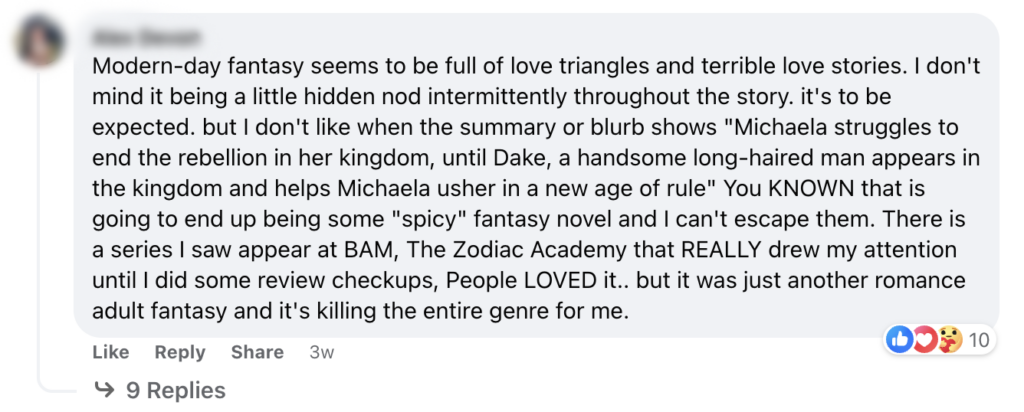
10. God-like characters
Readers can’t often get behind a character who doesn’t feel real. It’s becoming one of the writing pet peeves we just can’t shake. This is especially true if the character is unbeatable or solves all their problems because they’re this god-like being.
Now, if you give us this type of character and give them real, relatable problems, that changes.
Take Superman, for example. While he does have a weakness, he also has relatable issues like girlfriend problems and the like. That can cure this irritation a bit, but keep this peeve in mind!
11. Disabled or ugly villains
This one is pretty straightforward. It’s harmful to depict disabled or ugly people as your villains, especially if the “good guys” are able-bodied and beautiful. What kind of message does this send readers?
It’s immature writing, at best, and stems from childlike stories that need to depict the bad people as clearly bad, but this is flawed and should be changed. Be the change. Disabled villains is simply uncalled for unless they have a serious backstory of how the disability came to be. Do better and craft a diverse cast in general.

Writing Pet Peeves
Writing pet peeves are ones that I would consider to be more specific to the writing process than the overall book process. They’re more of the details and nitty-gritty creative tidbits.
Let’s take a look at the writing pet peeves readers tend to have the most problems with.
1. “Lazy” naming of holidays or other unique-world things
Okay. I’ll admit it. This one is mine. I cannot stand this in stories—especially those set in another world. It’s one of my worst writing pet peeves and is based on a book that calls a yearly celebration of the birth of a Goddesses only son Yulemas.
Let’s be more creative, pals.
There are even resources to help you! Here’s a blog post about how to name a fantasy world as well as one about naming characters that will give you a process for naming all types of things.
2. The woman main character is “too dumb” to figure it out
Unfortunately, this is fairly common, and reads as lazy writing. Honestly, if you can’t figure out how to create conflict in your story outside of a character just not understanding or being too dumb to put the pieces together, just get yourself a writing coach to help you figure it out!
There’s nothing wrong with being stuck in your plot. But there is something wrong with making the female main characters (FMC) the ones who are “too dumb” to put the pieces together.
Many people agreed with this one!

3. Modern figures of speech in a different world or time
This is another one of the writing pet peeves that’s usually an indication that the author needs a better editor. Or just an editor in general. Modern figures of speech have origins. Those origins are based in our culture and our history.
Which means they just don’t make sense in a different world or time in which those things don’t happen.
I once read a book where the author used, “spill the beans” as a method of “confessing something” in a unique fantasy world. When in reality, the phrase originates in ancient Egypt and therefore wouldn’t translate to a unique fantasy world. It might seem simple, but it has the power to disrupt the suspension of disbelief needed for books and is one of the big writing pet peeves to avoid.
4. Long, illogical naming of places
You can name things whatever you want, especially if you’re writing in your own world. But you will want to keep in mind that the reader will want to remember those names.
This reader has a great point:

5. Recycled dialogue
A lot of writing pet peeves will circle around dialogue. When you don’t know how to write dialogue well, readers will be unforgiving. That’s because the dialogue is what makes the story come to life. When you reuse dialogue in the sense that you’re just recycling conversations, phrasing, and the like from character to character, it’s boring.
The reader will likely put the book down.
Do yourself a favor and put some extra effort into making your dialogue stand out. Your readers will love you for it!
6. Novel openings that are dream sequences
This is just a cliche at this point, and very hard to do well. If you want to know how to open a book, just think about introducing the character’s everyday life, their current struggles, and their deepest want from the life they have now.
That can be done in any number of scenes and sequences, but it’s the best method to introduce character and kick off a story. Obviously, choose an exciting scene. Just don’t make that scene a dream, because the reader will feel betrayed if the first thing they read isn’t real.
7. Unpronounceable names
Not only is this one of the popular writing pet peeves, it’s also just bad for marketing. As I said on the post that you can see in the image below, if a reader can’t pronounce it, they won’t talk about it. That’s not good with word-of-mouth is such a powerful method of book marketing.
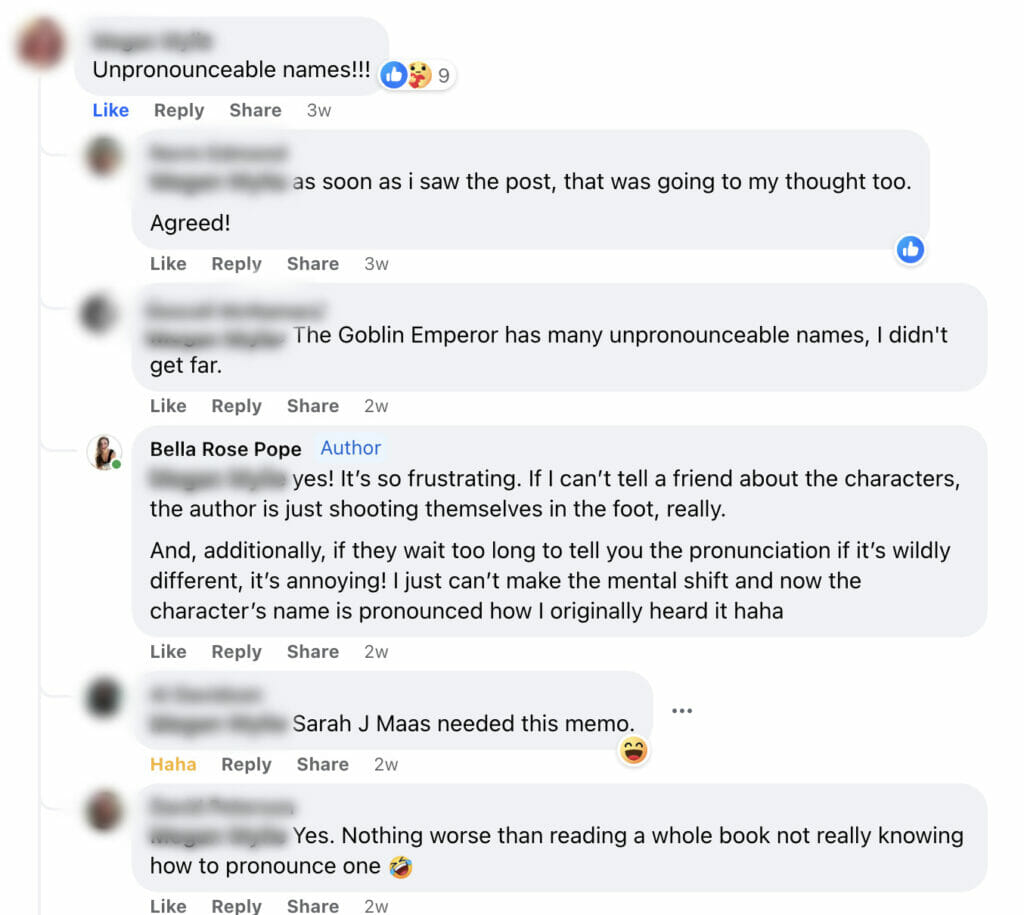
8. Character names that are too similar
Adding on to the character names writing pet peeves, we have this one. When names are too similar, it’s hard for readers to keep track of them. They’ll start mistaking one for the other, and a confused reader is never really a happy reader (unless they’re meant to be confused).
To keep things safe, just don’t use names that sound too similar or look similar in writing.
9. Plot-only dialogue
This can be a personal preference, but it’s also likely to become one of the writing pet peeves if you’re not careful. When the dialogue is only used to advance the plot and not to contribute to characterization or character relationships, it can become problematic.
This is usually because the dialogue will then feel stiff and inauthentic. The reader will feel like the characters are pawns and not actually real people. Even though they’re not real, readers will want to feel like they are!
10. Excessive scene-setting
Setting a scene is important. Giving too much detail to the extent that you bore readers can be detrimental. It’s a big book pet peeve that JRR Tolkien is famous for.
But, people still devoured his books, so do as you wish! Just know that some readers will be annoyed about it.
11. Info-dumps
Info-dumps are when the author just writes a bunch of backstory and detail (exposition) at once instead of weaving it into the story effectively. This is usually due to inexperience as an author, and most writers start out this way.
The art of effective-but-interesting exposition isn’t automatic and can take some time. Keep an eye on this in other books and figure out how authors are giving you details without this becoming one of your writing pet peeves for them.
12. Forgotten pets
While this isn’t in every type of story, it can be annoying when the animal is introduced as an important plot element, only to be forgotten about later. It’s a huge peeve because a reader will get excited about this character and will be upset when it’s lost!
Really with any elements of fiction, you want to make sure that if you introduce something, it serves a purpose. Even if the reader doesn’t know the purpose yet. It irritates readers when they’re reading and focus on something you, as the author, have inadvertently told them to focus on, only for it to not pay off in the end.
Because good books are often about the payoff of a reader paying attention to what you’ve told them! Truthfully, this trust as an author is what creates major fans over the course of your writing career.
Check out what this reader said about it and why it irks them:

The writing process is difficult and readers can be so picky. In order to get your book right from the start, consider taking this class on what it takes to write quality fiction so you can avoid these writing pet peeves altogether:
